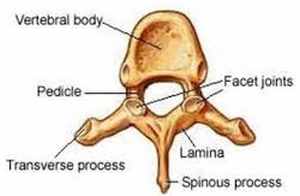

MedFriendly®


Lamina
Lamina is a flat layer or thin plate of membrane or other
tissue. Lamina may be part of a structure as are the
laminae (two broad plates) of the curved bony
structures that make up the spine (known as the lamina
of the vertebral arch). Surgical removal of the laminae
is known as a laminectomy. Lamina may also be
independent of other structures such as the lamina of
algae. This is a flattened structure that forms the main
body of plants that can be seen with the naked eye.
Lamina of the spinal column.
FEATURED BOOK: Healing Back Pain: The Mind-Body Connection
It is often developed into organs with special functions such as for floating. In plants, the
lamina is often an extension of the stipe, which is a stalk that supports some other
structure. Lamina can also refer to the flat part of a leaf.
Another type of lamina is the basal lamina, which is a structural support system that lines
the outer surface of epithelial cells. Epithelial cells are cells that help absorb, move, and
distribute some of the fluids and nutrients in the body.
There is also the nuclear lamina, which is a thick network of fibers inside the nucleus
(central structure) of certain cells. The plural of lamina is laminae.
Lamina is Latin for, "plate," meaning "bone."
"Where Medical Information is Easy to Understand"™















